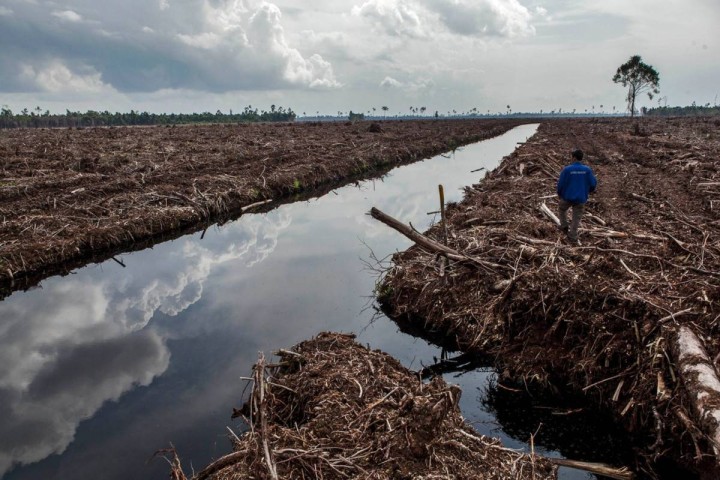What will it take to end deforestation by 2030?

A forest activist inspects land clearing and drainage of a peat natural forest in Riau province, Sumatra, Indonesia in 2014.
The world has lost a third of its forest since the last ice age, and an estimated 15 percent of global greenhouse gases still come from deforestation and forest degradation.
Now a new pledge made at the COP26 climate conference in Glasgow last month hopes to change this stark picture. The Glasgow Leaders’ Declaration on Forests and Land Use, signed by key forest nations, aims to reduce deforestation to zero by 2030. The pledge has raised hopes that the world would see a fresh impetus to curb the devastating impacts of deforestation.
“If we could get deforestation to zero, it would be an incredible achievement,” says Simon Lewis, a researcher of global change science at the University of Leeds and University College London. “Both in terms of carbon [...] and for biodiversity and conservation, because two-thirds of the world's species are in the world's tropical forests.”
But there are also serious caveats to the pledge, including the fact that similar declarations have been made before—often to little avail.
What’s the new pledge about?
It was announced at COP in early November and signed by 141 countries—some 72 percent of nations—including Brazil, Indonesia, and the Democratic Republic of the Congo, three of the four countries with the most tropical forest in 2020.
The countries are committed to “working collectively to halt and reverse forest loss and land degradation by 2030” while “delivering sustainable development and promoting an inclusive rural transformation.” Importantly, it does not qualify this by referring only to “illegal” deforestation as many other pledges do, meaning it’s attempting to cover all deforestation, not just logging or land clearance in violation of local laws.
The pledge is backed up by $12 billion in public funds and $7.2 billion in private financing. Within this, $1.7 billion will go to support the land rights of indigenous people and local communities and support their roles as forest protectors.
However, Lewis says there remains ambiguity about whether the pledge means “zero” deforestation or “net zero” deforestation. Zero deforestation would mean no loss of old growth forests anywhere. But net zero deforestation means old growth forests could still be cleared, so long as new forests were planted at the same rate. “The former is much better for carbon, and also much better for biodiversity,” Lewis explains.
What impact could it have?
It’s hard to overstate the effect of ending deforestation on everything from climate change and water security to wildlife and the welfare of indigenous communities.
An analysis by the World Resources Institute (WRI) found that ending forest loss by 2030 in all signatory countries of the pledge would avoid 33 million hectares of forest loss, an area roughly the size of Malaysia. It would also avoid emissions of 19 gigatonnes of carbon dioxide equivalent (GtCO2e), around twice the annual emissions of China.
“It would be a real contribution to the reduction of emissions in general,” says Adriana Ramos, coordinator of politics and law at Instituto Socioambiental (ISA) in Brazil. “When Brazil, for example, reduced emissions from deforestation, it was the biggest reduction of emissions all over the world. The reduction of deforestation is the cheapest and I would say almost the easiest way of reducing emissions.”
Maintaining forests also supports the agenda of climate change in other ways, she adds—by providing carbon storage and helping to maintain regional climate balance. The Amazon plays a huge role in regulating the microclimate of the continent.
Can we trust this pledge?
However, some are concerned about how far this pledge will really go toward halting deforestation.
Firstly, countries may have signed a grand declaration, but it does not set out exactly how they plan to achieve the goal, nor how implementation of the agreement will be tracked. There are also no provisions for what happens if countries don’t meet the deadline.
“If global leaders are serious about stopping forest destruction, then they must back up announcements with a commitment to bring in strong and binding national legislation that makes it illegal for companies and financial institutions to fuel deforestation,” says Jo Blackman, head of forest policy and advocacy at Global Witness.
The pledge also says nothing about dealing with the demand side of the drivers of deforestation, says Lewis. “If you don't curb demand for products that come from rainforest lands, then someone will supply that demand.” This could mean the Glasgow declaration, if abided by, could end up pushing deforestation to other countries that have not signed up to it, says Lewis. “[So] globally, you might not see any change in deforestation, you just might see it move.”
Many pointed out that a similar declaration made in 2014 in New York has failed to make much headway. This sought to halve tropical deforestation by 2020 and end it by 2030, but deforestation has actually risen since then, increasing especially sharply in 2020. A recent report on the New York declaration found that most forest nations have not embedded the goals in their latest UN climate pledges.
However, in some ways the new pledge is different from the 2014 version. Far more countries have signed up this time, and there is also funding and a suite of policies and actions to go with it, says Lewis. “It is more sophisticated than the New York Declaration on Forests was.”
It’s also significant that the pledge was mentioned in the major United States-China climate declaration made in the second week of COP26. Both countries said they intend to tackle illegal deforestation by “effectively enforcing their respective laws on banning illegal imports.”
“I haven't seen China say [before] on the world stage that it intends to do anything about deforestation,” says Lewis. “China has gone through the forest transition and is adding forest, not removing it, but it has a huge impact overseas.” The European Commission also last month released a draft law that aims to stop global deforestation driven by EU consumption of products such as soy, beef, and palm oil.
One caveat comes from Indonesia, which appeared to back away from the pledge shortly after signing up. Denying that the key plank of zero deforestation by 2030 was even part of the agreement, the country's vice foreign minister, Mahendra Siregar, argued that the pledge did not mean “zero deforestation,” but rather achieving no net loss of forested land.
While no such mutterings came from Brazil, Ramos is skeptical of the country’s commitment to the pledge. “Brazil has announced different pledges [on deforestation] at different moments since the government began,” she says. “[But] there is no sign in Brazilian politics that they are putting in place any strategy to really reduce deforestation. We are really worried that Brazil has only said that to be in the photograph of COP, but not on an honest basis.” Figures published shortly after COP26 show that Brazil’s rates of deforestation are now at their highest level in 15 years.
How can the aims be achieved?
The pledge was fairly thin on details, but much is already known about how to achieve deforestation. Brazil’s strong reduction in the late 2000s, for example, could point the way.
“We know what are the steps that the policy has to take,” says Ramos. This starts by implementing stronger controls to crack down on those that are illegally deforesting, she says. But it also means increasing support for more sustainable agricultural production and supporting other new economies based on the maintenance of forests, such as community-based tourism or harvesting forest products in a sustainable way.
Many were particularly enthused about the $1.7 billion in funding to support indigenous and local land rights. This money must reach the territories in an autonomous way for indigenous people, Ramos says, otherwise it could lead to governmental programs or big NGOs having more power within the territories than the communities themselves. Research has shown that targeted local support is a cost-effective way to limit climate change because indigenous peoples tend to be far better at managing forests in a sustainable way. On this point Ramos is resolute: “It's key to recognize the role that these people have in keeping the forest, and the necessity of supporting the maintenance of their territories.”

